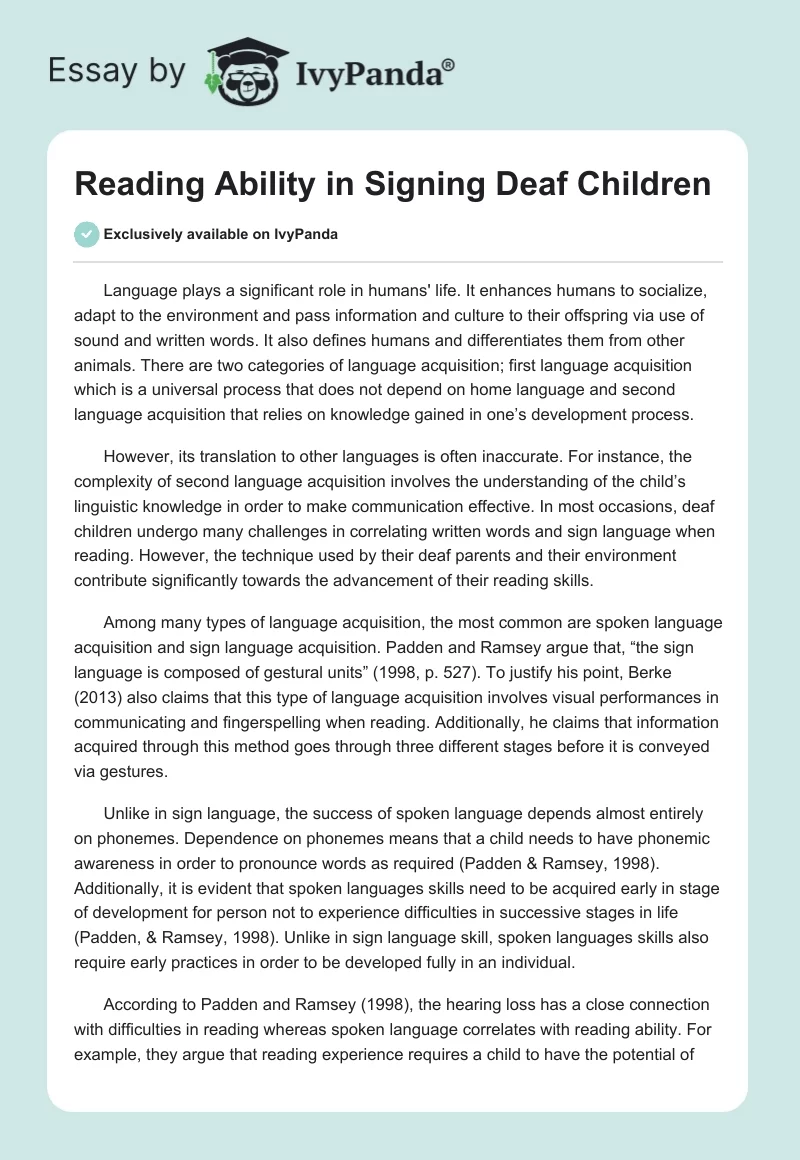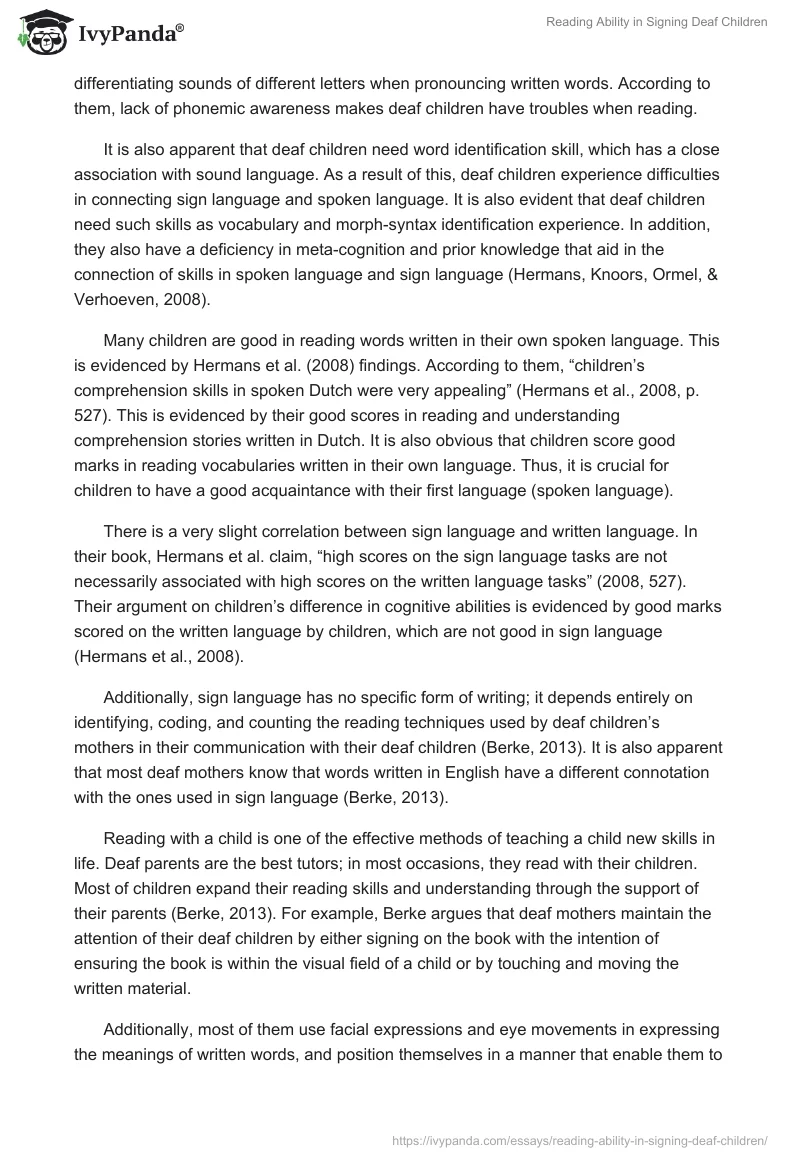Language plays a significant role in humans’ life. It enhances humans to socialize, adapt to the environment and pass information and culture to their offspring via use of sound and written words. It also defines humans and differentiates them from other animals. There are two categories of language acquisition; first language acquisition which is a universal process that does not depend on home language and second language acquisition that relies on knowledge gained in one’s development process.
However, its translation to other languages is often inaccurate. For instance, the complexity of second language acquisition involves the understanding of the child’s linguistic knowledge in order to make communication effective. In most occasions, deaf children undergo many challenges in correlating written words and sign language when reading. However, the technique used by their deaf parents and their environment contribute significantly towards the advancement of their reading skills.
Among many types of language acquisition, the most common are spoken language acquisition and sign language acquisition. Padden and Ramsey argue that, “the sign language is composed of gestural units” (1998, p. 527). To justify his point, Berke (2013) also claims that this type of language acquisition involves visual performances in communicating and fingerspelling when reading. Additionally, he claims that information acquired through this method goes through three different stages before it is conveyed via gestures.
Unlike in sign language, the success of spoken language depends almost entirely on phonemes. Dependence on phonemes means that a child needs to have phonemic awareness in order to pronounce words as required (Padden & Ramsey, 1998). Additionally, it is evident that spoken languages skills need to be acquired early in stage of development for person not to experience difficulties in successive stages in life (Padden, & Ramsey, 1998). Unlike in sign language skill, spoken languages skills also require early practices in order to be developed fully in an individual.
According to Padden and Ramsey (1998), the hearing loss has a close connection with difficulties in reading whereas spoken language correlates with reading ability. For example, they argue that reading experience requires a child to have the potential of differentiating sounds of different letters when pronouncing written words. According to them, lack of phonemic awareness makes deaf children have troubles when reading.
It is also apparent that deaf children need word identification skill, which has a close association with sound language. As a result of this, deaf children experience difficulties in connecting sign language and spoken language. It is also evident that deaf children need such skills as vocabulary and morph-syntax identification experience. In addition, they also have a deficiency in meta-cognition and prior knowledge that aid in the connection of skills in spoken language and sign language (Hermans, Knoors, Ormel, & Verhoeven, 2008).
Many children are good in reading words written in their own spoken language. This is evidenced by Hermans et al. (2008) findings. According to them, “children’s comprehension skills in spoken Dutch were very appealing” (Hermans et al., 2008, p. 527). This is evidenced by their good scores in reading and understanding comprehension stories written in Dutch. It is also obvious that children score good marks in reading vocabularies written in their own language. Thus, it is crucial for children to have a good acquaintance with their first language (spoken language).
There is a very slight correlation between sign language and written language. In their book, Hermans et al. claim, “high scores on the sign language tasks are not necessarily associated with high scores on the written language tasks” (2008, 527). Their argument on children’s difference in cognitive abilities is evidenced by good marks scored on the written language by children, which are not good in sign language (Hermans et al., 2008).
Additionally, sign language has no specific form of writing; it depends entirely on identifying, coding, and counting the reading techniques used by deaf children’s mothers in their communication with their deaf children (Berke, 2013). It is also apparent that most deaf mothers know that words written in English have a different connotation with the ones used in sign language (Berke, 2013).
Reading with a child is one of the effective methods of teaching a child new skills in life. Deaf parents are the best tutors; in most occasions, they read with their children. Most of children expand their reading skills and understanding through the support of their parents (Berke, 2013). For example, Berke argues that deaf mothers maintain the attention of their deaf children by either signing on the book with the intention of ensuring the book is within the visual field of a child or by touching and moving the written material.
Additionally, most of them use facial expressions and eye movements in expressing the meanings of written words, and position themselves in a manner that enable them to monitor the reactions of their children while reading (Berke, 2013). More than that, deaf mothers use different fonts in teaching their children on how to differentiate emotions expressed in words.
In their book, Hermans et al. (2008) expound on how children understand the meaning of words written in their initial language more easily than those from other languages. According to them, skills acquired in the first language contribute significantly to the acquisition of a second language. For example, they claim that sign language contribute significantly towards the development of literacy skill in deaf children. They also assert that the environment of deaf children allows them to gather many signs that correlate with reading vocabularies. Association of deaf children with factors such as coolness and attentiveness triggered by the environment also contribute significantly to deaf children’s broad understanding of written materials.
It is crucial for all children regardless of disability to know how to read. Unfortunately, this can be met only by identifying the disability of born children as early as possible. For example, early identification of deafness in a child allows parents not only to set up a learning environment for the child, but also to help their deaf children understand and develop skills required for learning literature.
In conclusion, language is a form of communication that involves the usage of sound, written words or signs. Its acquisition is very complex; in most occasions, it involves the understanding of the child’s linguistic knowledge. It also involves correlating written words and sign language. Unfortunately, children with disabilities such as deaf children undergo many challenges when correlating the two methods. However, the use of techniques such as facial expressions and eye movements in expressing the meanings of written words by deaf parents contribute significantly to deaf children’s acquaintance of reading skills.
References
Berke, M. (2013). Reading Books with Young Deaf Children: Strategies for Mediating Between American Sign Language and English. Journal of Deaf Studies and Deaf Education, 18(3), 299-311. Web.
Hermans, D., Knoors, H., Ormel, E., & Verhoeven, L. (2008). The Relationship between the Reading and Signing Skills of Deaf Children in Bilingual Education Programs. Journal of Deaf Studies and Deaf Education, 13(4), 518-530. Web.
Padden, C. & Ramsey, C. (1998). Reading Ability in Signing Deaf Children. Topics in language disorders, 18(4), 30-46.


